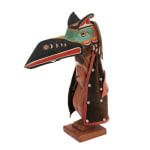-
Artworks
PETER JOSEPH, KWAKWA̱KA̱ʼWAKW, QUATSINO, B.C.
Man Raven Dancing, c. 1980cedar, acrylic paint, fabric, leather, plastic buttons, and cotton thread, 14 x 8.5 x 4.5 in (35.6 x 21.6 x 11.4 cm)
titled and signed, "MAN / RAVEN / DANCING / by / Peter / Jospeh".LOT 105
ESTIMATE: $400 — $600
PRICE REALIZED: $384.00Further images
-
(View a larger image of thumbnail 1
)

-
(View a larger image of thumbnail 2
)

-
(View a larger image of thumbnail 3
)

-
(View a larger image of thumbnail 4
)

-
(View a larger image of thumbnail 5
)

-
(View a larger image of thumbnail 6
)

-
(View a larger image of thumbnail 7
)

-
(View a larger image of thumbnail 8
)

A sculpture representing a Raven Hamatsa dancer. The Raven Hamatsa is one of three variations of cannibal birds used in the Hamatsa Dance ritual – the most important ritual of...A sculpture representing a Raven Hamatsa dancer. The Raven Hamatsa is one of three variations of cannibal birds used in the Hamatsa Dance ritual – the most important ritual of the Kwa-waka’wakw dance ceremonies. The figure is also wearing a button robe, a robe created from trade blankets of melton cloth and appliqued with crest designs outlined with abalone shell or commercial buttons.
The Raven is critical to the presentation of the Hamatsa. The three birds, Raven, Huxwhukw and Galukwami (Crooked Beak of Heaven) are the supernatural guardians of Baxwbakwakanuksiwe, the cannibal of the north end of the world. The large scale is physically demanding and challenging to dance so to test the worthiness of the dancer. These large headdresses are danced by initiates earning rights and privileges within the secret societies. The dancer enters the ceremonial hall having just returned from the forest where they experience cold, isolation, hunger encounters with animals, and possession by the supernatural world. During the ceremony, the initiate is ceremonially tamed but retains the knowledge that had been earned in the forest.
Peter Joseph is from Quatsino a remote boat-access only community of less than a hundred people on the northern coast of Vancouver Island. He works often in miniature with jewellery, model totem poles and sculpted figures.
– Gary Wyatt
Provenance
Private Collection -
(View a larger image of thumbnail 1
)
Join our mailing list
* denotes required fields
We will process the personal data you have supplied in accordance with our privacy policy (available on request). You can unsubscribe or change your preferences at any time by clicking the link in our emails.








